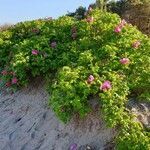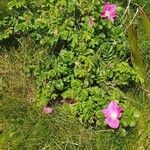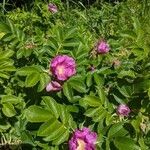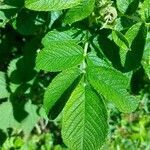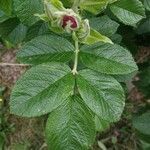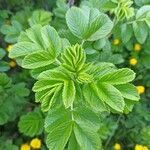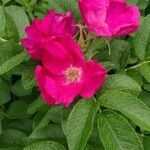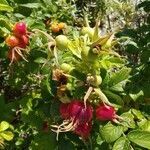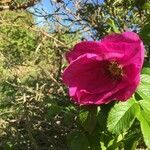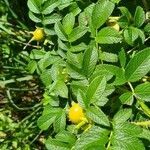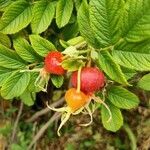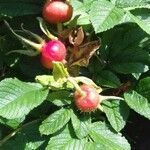Deciduous, erect or suberect, densely suckering and thicket-forming shrub to 2 m high; stems stout and rigid, densely tomentose; armature of large, straight, narrow and slightly flattened prickles or pricklets. Lvs with (2)-3-4 pairs of leaflets; petioles 20-50 mm long, densely tomentose; stipules adnate for most of length, very broad and ± leafy, tomentose, denticulate. Lamina of leaflets 20-50 × 8-30 mm, elliptic or broadly elliptic, rugose, shining, rather dark green and with scattered eglandular hairs above, ± tomentose and with numerous very short glandular hairs beneath; margins serrate or crenate, slightly recurved; base ± rounded; apex obtuse or subacute. Fls 1-4, single (often semi-double or double in cultivation), c. 40-80 mm diam. Pedicels moderately hairy to tomentose, with ± scattered, rigid, straight, glandular hairs. Sepals persistent, lanceolate or ovate-lanceolate, long-acuminate or spathulate towards apex, tomentose inside, tomentose and with scattered stiff glandular hairs outside; outer sepals entire or with a few small teeth near apex. Petals 35-50 mm long, broadly obovate, deep rosy crimson. Styles free, shortly exserted and forming a large head, hairy. Fr. 20-25 mm across, ± depressed-globose, glabrous, shining deep red.
More
A prickly shrub. It grows 1.5-2.4 m high and spreads 1.5-2.4 m wide. It has stout prickles. The leaves are dark green and have a wrinkled surface. It loses its leaves during the year. The leaves turn orange in autumn. The flowers are purple-pink and single. The fruit are rose-hips 2.5-5 cm across. They are red.
The rosehips are made into wine, tea, syrup, jelly or tarts. The petals are used for scenting tea. They are also nibbled, used in salads, candied and used for jam, and syrup. The unripe fruit can be peeled, cooked and eaten. The young shoots are boiled or steamed and served as a potherb.
